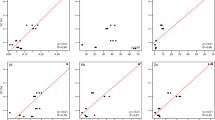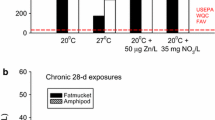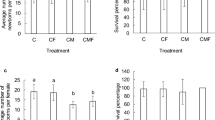Abstract
The amphipod Melita plumulosa is commonly used to assess the toxicity of contaminated sediments. Seven-day-old M. plumulosa are <1 mm in size, and during 10-day tests in sandy sediments with low nutritional value, starvation can cause >50% mortality. In sediment toxicity tests, therefore, it can be difficult to determine if toxicity is due to contaminants or starvation, particularly in contaminated sandy sediments. This study investigated the influence of amphipod age and food addition on amphipod survival in toxicity tests. The 4-day LC50 increased linearly from 120 to 470 μg/L when M. plumulosa age at the beginning of the test increased from 5 to 30 days. The addition of food as algae or fish food did not significantly affect the sensitivity of 11-day-old M. plumulosa (11-d Mp) to dissolved copper over 4 days in water-only tests. The survival of 11-d Mp in water-only tests over 10 days was poor without feeding, but when fed fish food, the 10-day LC50 was 76 ± 15 μg/L. In sediment tests, feeding 0.063 mg fish food/amphipod on days 3 and 7 of 10-day tests consistently resulted in greater than 80% survival of 11-d Mp for a range of clean, sandy sediments, which had low amphipod survival without added food. Algae were not always suitable as a food source, as their growth can be stimulated by nutrients released from sediment and was inhibited by contaminants. The toxicity of most contaminated sediments was not ameliorated by the addition of food, suggesting that food addition was suitable for inclusion in routine testing protocols for this amphipod.





Similar content being viewed by others
References
Ankley GT, Benoit DA, Balogh JC, Reynoldson TB, Day KE, Hoke RA (1994) Evaluation of potential confounding factors in sediment toxicity tests with three freshwater benthic invertebrates. Environ Toxicol Chem 13:627–635
Ankley GT, Blazer VS (1988) Effects of diet on PCB induced changes in xenobiotic metabolism in the liver of channel catfish (Ictalurus punctatus). Can J Fish Aquat Sci 45:132–137
ASTM (2002) Standard guide for conducting 10-day static sediment toxicity tests with marine and estuarine amphipods. ASTM Designation: E 1367–99. American Society for Testing and Materials, Philadelphia
ASTM (2003) Standard test method for measuring the toxicity of sediment-associated contaminants with estuarine and marine invertebrates. ASTM designation: E 1367-03. American Society for Testing and Materials, Philadelphia
Barry MJ, Logan DC, van Dam RA, Ahokas JT, Holdway DA (1995) Effect of age and weight-specific respiration rate on toxicity of esfenvalerate pulsed-exposure to the Australian crimson-spotted rainbow fish (Melanotaenia fluviatilis). Aquat Toxicol 32:115–126
Bridges TS, Farrar JD (1997) The influence of worm age, duration of exposure and endpoint selection on bioassay sensitivity for Neanthes arenaceodentata (Annelida:Polychaeta). Environ Toxicol Chem 16:1650–1658
Bridges TS, Farrar JD, Duke BM (1997) The influence of food ration on sediment toxicity in Neanthes arenaceodentata (annelida: polychaeta). Environ Toxicol Chem 16:1659–1665
Castro H, Ramalheira FM, Quintino V, Rodrigues AM (2006) Amphipod acute and chronic sediment toxicity assessment in estuarine environmental monitoring: an example from Ria de Aveiro, NW Portugal. Marine Pollut Bull 53:91–99
Emery VL, Moore DW, Gibson AB, et al. (1997) Development of a chronic sublethal sediment bioassay using the estuarine amphipod Leptocheirus plumulosus (Shoemaker). Environ Toxicol Chem 16:1912–1920
Forget J, Pavillon JF, Menasria MR, Bocquene G (1998) Mortality and LC50 values for several stages of the marine copepod Tigriopus brevicornis exposed to the metals arsenic and cadmium and the pesticides atrazine, carbofuran, dichlorvos, and malathion. Ecotoxicol Environ Safety 40:239–244
Gale SA, King CK, Hyne RV (2006) Chronic sublethal sediment toxicity testing using the estuarine amphipod, Melita Plumulosa (zeidler): evaluation using metal-spiked and field-contaminated sediments. Environ Toxicol Chem 25:1887–1898
Harkey GA, Driscoll SK, Landrum PF (1997) Effect of feeding in 30-day bioaccumulation assays using Hyalella azteca in fluoranthene-dosed sediment. Environ Toxicol Chem 16:762–769
Hoang TC, Klaine SJ (2007) Influence of organism age on metal toxicity to Daphnia magna. Environ Toxicol Chem 26:1198–1204
Hoang TC, Tomasso JR, Klaine SJ (2004) Influence of water quality and age on nickel toxicity to fathead minnows (Pimephales promelas). Environ Toxicol Chem 23:86–92
Hyne RV, Gale SA, King CK (2005) Laboratory culture and life cycle experiments with the benthic amphipod Melita plumulosa (Zeidler). Environ Toxicol Chem 24:2065–2073
King CK, Simpson SL, Smith SV, Stauber JL, Batley GE (2005) Short-term accumulation of Cd and Cu from water, sediment and algae by the amphipod Melita plumulosa and the bivalve Tellina deltoidalis. Marine Ecol Prog Ser 287:177–188
King CK, Gale SA, Stauber JL (2006) Acute toxicity and bioaccumulation of aqueous and sediment-bound metals in the estuarine amphipod Melita plumulosa. Environ Toxicol 21:489–504
Klein B (2000) Age as a factor influencing results in the acute daphnid test with Daphnia magna Straus. Water Res 34:1419–1424
Klüttgen B, Ratte HT (1994) Effects of different food doses on the acute and chronic toxicity of copper to Daphnia magna. Environ Toxicol Chem 13:1619–1627
Lanno RP, Hickie BE, Dixon DG (1989) Feeding and nutritional considerations in aquatic toxicology. Hydrobiologia 188/189:525–531
Levy JL, Stauber JL, Jolley DF (2007) Sensitivity of marine microalgae to copper: the effect of biotic factors on copper adsorption and toxicity. Sci Total Environ 387:141–154
Mann RM, Hyne RV (2008) Embryological development of the Australian amphipod, Melita plumulosa Zeidler, 1989 (Amphipoda, Gammaridea, Melitidae). Crustaceana 81:57–66
McGee BL, Schlekat CE, Reinharz E (1993) Assessing sublethal levels of sediment contamination using the estuarine amphipod Leptocheirus plumulosus. Environ Toxicol Chem 2:577–578
McGee BL, Fisher DJ, Wright DA, et al. (2004) A field test and comparison of acute and chronic sediment toxicity tests with the estuarine amphipod Leptocheirus plumulosus in Chesapeake Bay, USA. Environ Toxicol Chem 23:1751–1761
Melo SLR, Nipper M (2007) Sediment toxicity tests using the burrowing AMPHIPOD Tiburonella viscana (Amphipoda : Platyischnopidae). Ecotoxicol Environ Safety 66:412–420
Nipper M, Roper DS (1995) Growth of an amphipod and a bivalve in uncontaminated sediments: implications for chronic toxicity assessments. Marine Pollut Bull 31:424–430
Norberg-King TJ, Sibley PK, Burton A, et al. (2006) Inter-laboratory evaluation of Hyalella azteca and Chironmus tentans short-term and long-term sediment toxicity tests. Environ Toxicol Chem 25:2662–2674
Pesch CE, Munns WR, Gutjahr-Gobell R (1991) Effects of a contaminated sediment on life history traits and population growth rate of Neanthes arenaceodentata (Polychaeta: Nereidae) in the laboratory. Environm Toxicol Chem 10:805–815
Scarlett A, Roeland SJ, Canty M, Smith EL, Galloway TS (2007) Method for assessing the chronic toxicity of marine and estuarine sediment-associated contaminants using the amphipod Corophium volutator. Marine Environ Res 63:457–470
Simpson SL (2001) A rapid screening method for acid-volatile sulfide in sediments. Environ Toxicol Chem 20:2657–2661
Simpson SL, Batley GE (2003) Disturbances to metal partitioning during toxicity testing of iron(II)-rich estuarine pore waters and whole sediments. Environ Toxicol Chem 22:424–432
Simpson SL, Batley GE (2007) Predicting metal toxicity in sediments: a critique of current approaches. Integrated Environ Assess Manag 3:18–31
Simpson SL, Rochford L, Birch GF (2002) Geochemical influences on metal partitioning in contaminated estuarine sediments. Marine Freshwater Res 53:9–17
Simpson SL, Batley GE, Chariton AA, et al. (2005) Handbook for sediment quality assessment. CSIRO, Bangor, NSW. Available at http://www.clw.csiro.au/cecr/publications.html
Simpson SL, Micevska T, Adams MS, Stone A, Maher W (2007) Establishing cause-effect relationships in PAH and hydrocarbon contaminated sediments using the benthic marine alga, Entomoneis cf punctulata. Environ Toxicol Chem 26:163–170
Thain J, Roddie B (2002) Biological effects of contaminants: Corophium sp. Sediment bioassay and toxicity test. ICES Techniques in Marine Environmental Sciences No. 28. In the Exploration of the Sea, Copenhagen
US EPA (1996) Test methods for evaluating solid waste, physical/chemical methods, SW-846. United States Environmental Protection Agency, Office of Solid Waste, Economic, Methods, and Risk Analysis Division, Washington, DC
Acknowledgments
Ian Hamilton is thanked for assisting with amphipod culturing and some toxicity tests. Jenny Stauber, Graeme Batley, Anu Kumar, and two other anonymous reviewers are thanked for their comments on the manuscript before publication.
Author information
Authors and Affiliations
Corresponding author
Additional information
An erratum to this article can be found at http://dx.doi.org/10.1007/s00244-008-9238-y
Rights and permissions
About this article
Cite this article
Spadaro, D.A., Micevska, T. & Simpson, S.L. Effect of Nutrition on Toxicity of Contaminants to the Epibenthic Amphipod Melita plumulosa . Arch Environ Contam Toxicol 55, 593–602 (2008). https://doi.org/10.1007/s00244-008-9153-2
Received:
Accepted:
Published:
Issue Date:
DOI: https://doi.org/10.1007/s00244-008-9153-2




